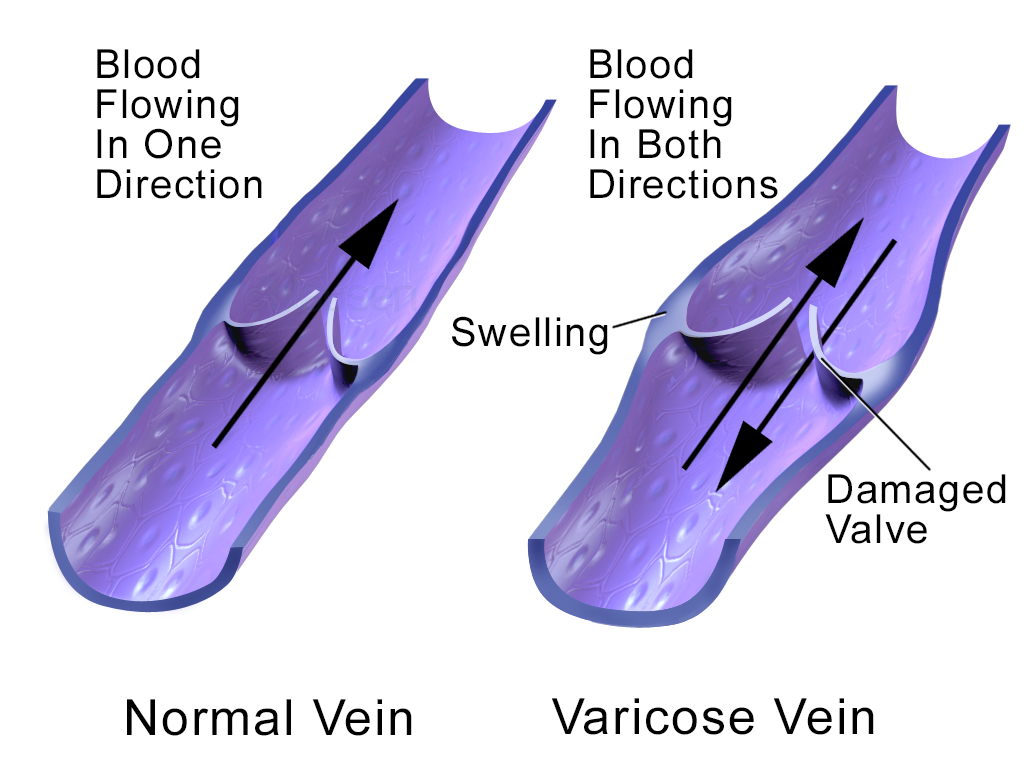What are varicose veins?
Varicose veins are swollen veins that you can see through your skin. They often look blue, bulging, and twisted. Left untreated, varicose veins may worsen over time.

You have three kinds of veins in your legs; the superficial veins, which lie closest to your skin, the deep veins, which lie in groups of muscles and perforating veins, which connect the superficial veins to the deep veins. Varicose veins occur in the superficial veins in your legs.
Factors that can increase your risk for varicose veins include having a family history of varicose veins, being overweight, not exercising enough, smoking, standing or sitting for long periods of time, or having DVT. Women are more likely than men to develop varicose veins. Being overweight or pregnant or having a job where you must stand for long periods of time increases pressure on leg veins. Symptoms of varicose veins may become more severe a few days before and during a woman’s menstrual period.
What causes varicose veins?
When you are in the upright position, the blood in your leg veins must work against gravity to return to your heart. To accomplish this, your leg muscles squeeze the deep veins of your legs and feet. One-way flaps, called valves, in your veins keep blood flowing in the right direction. This prevents blood from flowing in reverse, back down the legs. Important valves are present at the top of your thigh and the back of your knee.
In some cases, varicose veins can be a sign of an old blockage in the deeper veins called deep vein thrombosis.

Varicose Veins – Symptoms
- A dull ache, burning, or heaviness in the legs. These symptoms may be more noticeable late in the day or after you have been sitting or standing for a long time.
- Mild swelling, usually involving the feet and ankles only.
- Itching skin over the varicose vein.
Complications include:
- Skin blackening or darkening (stasis pigmentation) around the ankles and lower legs.
- Dry, stretched, swollen, itching, or scaling skin.
- Superficial thrombophlebitis (blood clot and inflammation)
- Open wounds (ulcers)- they may be especially severe and may not heal for years.
- Bleeding and/or bruising after a minor injury.
- Fungal and bacterial infections.
What tests will I need?
You may be asked to have a Venous Doppler Ultrasound scan done to confirm the source of leak and to plan treatment. The scan does not need you to be fasting and is painless.
How are varicose veins treated?
Your vascular surgeon will advise you regarding which procedure is the best for your particular situation. The options considered include.
Compression Stockings
Your doctor may prescribe compression stockings. Compression stockings are strong elastic socks that squeeze your veins and stop excess blood from flowing backward.
Endovenous Treatment
This is similar to “laparoscopic surgery” or “keyhole surgery” done in other parts of the body.
Your surgeon uses a thin, flexible tube called a catheter inserted into a vein in the leg. Using energy generated either by laser (light) or radio waves the inner wall of the vein is heated, that results in closure of the damaged vein. Once the leaking vein is closed it prevents further reverse flow of blood and treats the varicose vein.
These procedures are more comfortable alternatives to traditional surgery for varicose veins and for this reason, will now usually be offered to you first. They can be carried out under local anaesthetic or general anaesthesia, dependent on your choice.
Recovery is very fast and you can go home the same day if you like, though some patients chose to remain in hospital overnight. Patients are able to start walking almost immediately after the procedure and can return to work the next day if they like. You can expect some bruising and tightness in your legs for a few days after the
This procedure may be combined with another smaller operation called “micro-phlebectomy” or “sclerotherapy”.
Micro-Phlebectomy
This is a process by which the large bulging veins in the leg are removed tiny cuts of a few mm each. The abnormal vein is removed through these small cuts. This is often combined with endovenous treatment as the former treats the main source of leak while the micro-phlebectomy can remove the remaining abnormal veins.
Sclerotherapy
During sclerotherapy, your physician injects a chemical into your varicose veins. This chemical blocks the vein so your abnormal veins can then no longer fill with blood. Blood that would normally return to the heart through these veins returns to the heart through other veins. Your body will eventually absorb the veins that received the injection.

